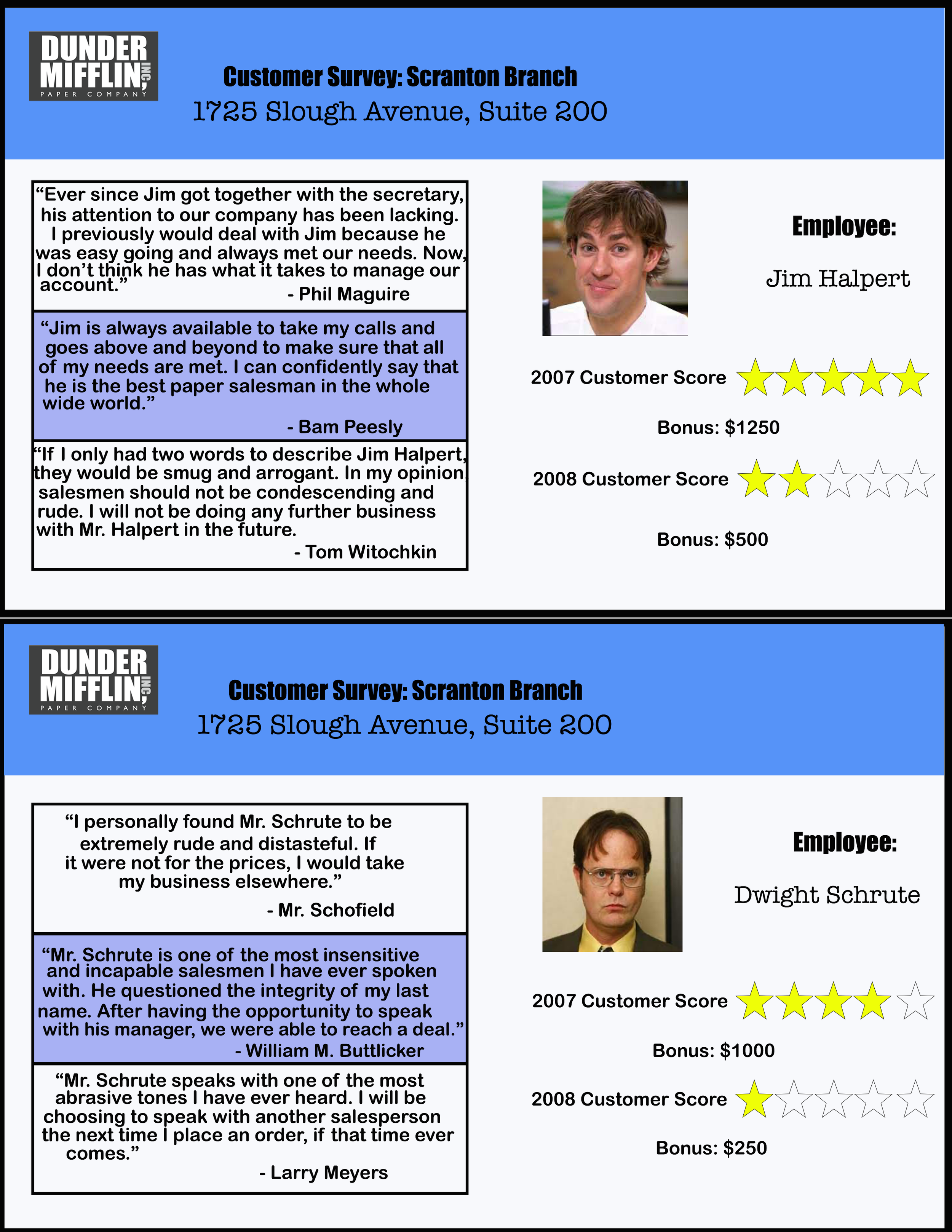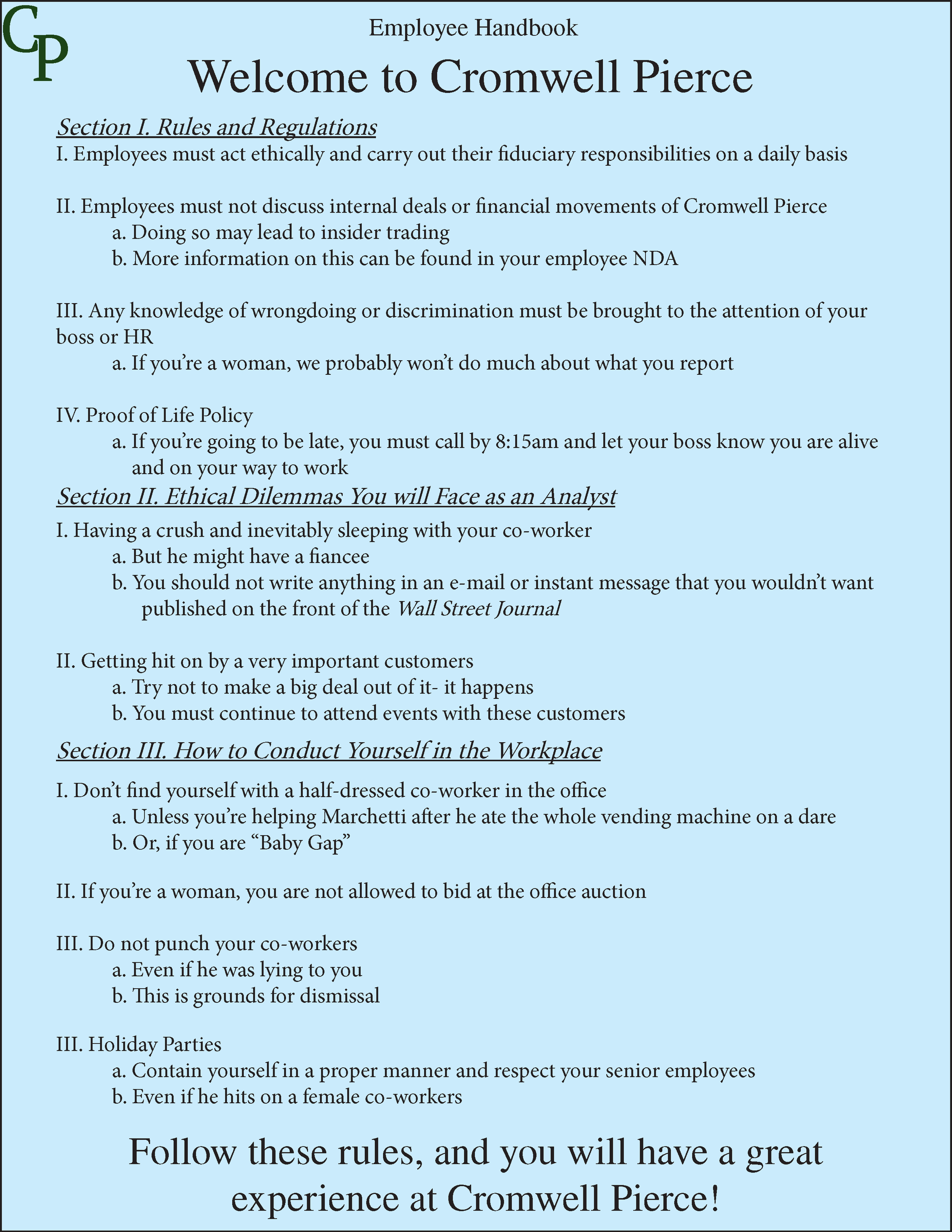Teaching with Technology: Assignment: Adaptation
This post is part of a series that comprise my Penn State Teaching with Technology (TWT) Portfolio. More information on TWT and links to each of these posts can be found at this hub page.
Teaching with Technology Rubric Item: Your CHOICE: Pedagogical Innovation with Technology (II)
In the final assignment for my Business and Literature course, I tasked students with producing a document or media piece that is referred to in one of the works we studied, or one that they imagine might conceivably appear within the storyworld of one of those works. They were to also write an essay explaining their design choices, and back those choices up with close readings of the text and historical research on the period and workplace depicted. In this way, the adaptation project served as a sort of capstone, building on those close reading and historicization skills that they exercised in previous assignments, but it also created a space for students to exercise creative skills, ones that they may have brought with them to the classroom, but hadn’t yet had the opportunity to apply.
To encourage students to develop computer skills that may be useful in their professional work, beyond the Microsoft Office applications that were already well-represented in assignments, I required that they use applications from Adobe’s Creative Cloud suite, which all students at my institution had access to. To give students a greater sense of agency, and in acknowledgment that no single application is ideally suited for all projects, I allowed them to select the application that would best suit the project they envisioned. To support this wide range of options, I directed students to courses on LinkedIn Learning, also freely available through the institution. An in-class tutorial on Adobe Express (then named Creative Cloud Express), a relatively simple online tool, meant that all students had at least some basic instruction in one of these tools. Students with a deeper investment in developing media production skills were free to use tools like Photoshop and InDesign.
The assignment was successful in that most students were able to select an appropriate application, conceptualize and create a project that met this criteria, and develop some new understanding of the work based on this synthesis of close reading, historicization, and this creative practice. Responses to the specific technology requirements were mixed: one student, more familiar with other tools, felt limited by the requirement to use one of these applications, while others wished for more instruction within a single professional application. If I were to use this assignment again, I would consider providing more instruction focused on a single application. InDesign. Most students defaulted to Adobe Express, and while it is a very capable tool, expertise in its use may be less compelling to prospective employers than experience with an industry-standard application like InDesign.
Sample Projects
Shared with permission.
Make or Break: Customer Reviews
by Ryan
Ryan’s project fuses his deep knowledge of the sitcom The Office with research into how companies compensate employees based on customer feedback. In his reflection, he writes:
Since it was mentioned in the episode that bonuses were based on customer feedback, I created a standard ranking system from one to five stars that would demonstrate the average performance of both Jim and Dwight. I then determined that bonuses could be valued at $250 for each star the salesperson received on their overall performance ranking. Above the current year of 2008’s performance and bonus, I also included the previous year’s performance and bonus to emphasize how much worse the current survey was than in previous years….This media piece not only looks at what the customer surveys may have looked like but also incorporates a theme of dry humor that is similar to that found in The Office.
Bond Girl Employee Handbook Adaptation
by Sophia
In Erin Duffy’s novel Bond Girl, the protagonist lands her dream job working for a Wall Street firm, but must contend with a male-dominated, misogynistic work environment. Sophia’s faux-HR document satirizes the firm’s working conditions, putting the unwritten rules of its work culture and references to the novels’ events into a professional-looking document.
In her reflection, Sophia writes:
Before starting this project, I participated in a LinkedIn Learning Course that addressed how to create an employee handbook. One of the points the speaker made was to keep things simple so that they can be easily understood and remembered. I used these skills to generate a proper one page document that highlighted the most important issues. I then applied this general information to the details of Bond Girl and what a handbook would look like within Cromwell Pierce….
After reading Bond Girl, I noticed there are many unethical and harmful problems within the company. However, they are dismissed because it is considered the “culture” of the Cromwell Pierce. Although my project may come off as satirical, it should be noted that this is not the way a company should operate or conduct its business. In fact, this handbook might be the opposite of what a real-world one should contain.
Assignment Sheet
DELIVERABLES
A single .PDF file submitted in Canvas containing:
A piece of visual media or a document designed using an Adobe Creative Cloud application, appearing as you imagine it might be found within the storyworld of one of the works you read or watched this semester (see instructions below for further explanation).
A 750-word reflection explaining how you selected your project, what you intended for it to communicate, and describing the close readings and historical research that influenced the form and content of your piece.
The “working file” of your piece submitted in Canvas, in the default file format of your chosen application (e.g. .PSD, .AI, .INDD, etc.).
If you produced your piece in Adobe Creative Cloud Express, select the "Invite to Project" icon in the upper right corner of the screen. Add my email address to give me editing permissions, and then below that, select the "Copy Link" option. Paste that link into the comments section of the Canvas submission.
DUE DATE
Friday, April 29 at 11:59 p.m.
THE PURPOSE OF THIS ASSIGNMENT IS TO
Create knowledge through this creative practice, and through reflecting on this creative practice.
Within a single project, apply both the close reading and historicization skills that you have developed throughout the semester to interpret a work.
Develop a rhetorical literacy of an Adobe Creative Cloud software application, a staple software suite for advertising and media businesses.
This supports a computing literacy pedagogy project developed in collaboration between Adobe and Penn State’s Digital English Studio.
Contribute to a collective body of knowledge that you can take with you after you finish this course.
I will e-mail you a PDF containing all Adaptation Projects and Reflections after the end of the course.
ASSESSMENT NOTIFICATION TIMING AND CRITERIA
Within three business days of the due date, I will record the grade it has earned according to the rubric linked here, based on the following criteria:
Media Piece
Completion, Length: is the piece sufficiently long/complex for this assignment’s considerable point value? A rough guideline is as follows:
Primarily text pieces (e.g. compilation of e-mails, text message exchanges, website pages, or journal entry): 750 words total
Social Media Graphics or Photos: a series of at least 3 images, including caption and alt text either in the images or in a document bundled into the .PDF.
Video: 0:45--1:30, depending on editing and graphics
Design & Demonstration of Functional Literacy: how well does the piece make use of the chosen application? How well does the piece simulate the chosen type of media piece? Has the writer submitted the original working file or Creative Cloud Express link?
Relation to Primary Work: how well and how specifically does the piece adapt a specific theme, keyword, or concept from the primary work?
Reflection
Completion, Length: what percentage of 750 words have been completed
Completion, Bibliography: the presentation includes a bibliography listing the primary work and at least one other source in Chicago Manual of Style, 17th Edition Bibliography format.
Indication of Trajectory: evidence of the different ways the author thought about the work before, during, and after completing the media piece.
Demonstration of Rhetorical Literacy: how well the reflection articulates a clear purpose behind creating the piece, and their critical understanding of the software application’s affordances and constraints
Argument: how well the reflection articulates the author’s understanding of the term, concept, or theme of the primary work that they have attempted to represent and their opinion or interpretation of it.
Close Reading: quality of close readings used in the reflection
Historicization: quality of historical research and incorporation of sources
Spelling, Grammar, and Punctuation: how “correct” the reflection is in these respects
Style: quality of sentences and paragraphs used to articulate the writer’s ideas. Language specificity, word choice, clarity, and appropriate complexity.
SPECIAL NOTES
This is a complicated project on paper, but trust that my intent behind it is to create different way for you to engage with the study of literature, one that may play to a range of strengths different from academic essay writing, and might (amidst the stressful end to the semester) even offer a bit of fun.
INSTRUCTIONS
These instructions work like bumpers in a bowling alley: they do not guarantee success, but they limit the chances of things going wrong. Particularly if you are very comfortable with this type of project, you can follow your own path towards meeting the assignment’s criteria. But do skim these in any case, as they may include important technical formatting information.
Pick a work we’ve studied this semester.
Identify a theme, concept, or keyword within it that you find particularly interesting.
Brainstorm a list of documents or media pieces that would exist in the storyworld of that work and that would exemplify that theme, keyword, or concept.
Possible choices might include corporate videos, social media graphics and photographs, company and team webpages, employee annual review forms, email and text message exchanges, and more.
The work itself might provide hints, as characters may refer to an e-mail exchange, document, or website that does not appear in the work verbatim.
Considering your own experience authoring or designing digital media, select a type of piece that you feel reasonably confident that you could produce by the due date, and select the Adobe application best suited for producing it.
For beginners, I recommend Adobe Creative Cloud Express or Premiere Rush, which we will go over in class. More advanced users may wish to experiment with professional applications such as Adobe XD, Photoshop, Illustrator, InDesign, or others.
Identify a purpose for your piece. What of your understanding of the primary work do you want it to communicate or convey?
Create a rough draft of your piece.
Create rough draft of your reflection. Consider the following questions:
Why did you choose the piece that you did?
What do you intend for it to look like and to communicate?
How did the software application you used enable or constrain what you were able to do?
What close reading evidence and historical evidence informs the creative choices you made?
What further questions might the production of this piece have helped surface?
What might be the answers to those questions, and what close readings and historical evidence can you use to support those answers?
Revise both rough drafts, focusing on high-level issues.
Proofread both rough drafts.
Combine final versions into a single .PDF.
Submit the .PDF and working file to Canvas.

